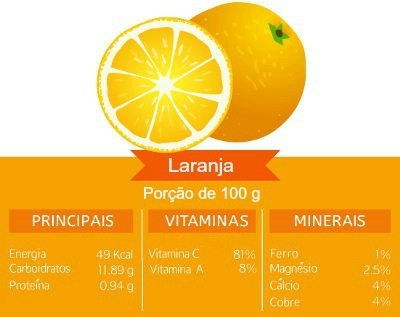Calorie is a unit of measurement used to represent energy in the form of heat (thermal energy), but it is not part of the International System of Units (SI). The SI unit of measure for heat is the Joule (J).
Since 1948, the calorie is defined as the amount of energy needed to raise the temperature of 1 gram of water by 14.5 OC for 15.5 OÇ. This same definition holds if we refer to the elevation of 1 OC at the temperature of 1 kg of water.
Such as calorie it is not the official heat measurement unit, we must know how to relate it to the Joule unit. It is known that 1 calorie is equivalent to 4.1868 J. If we use the variation of units, such as Kcal, the relationship is exactly the same, that is, 1 Kcal is equivalent to 4.18 KJ.
Energy production from food
The production of energy in the human body from food takes place inside the cells, more precisely in the cytoplasmic organelle called mitochondria. Energy is produced from one or more of the following nutrients as fuel:
Carbohydrates (such as glucose, sucrose and lactose);
Proteins (such as leucine and isoleucine);
Lipids (like oils and fats).
Inside the mitochondria, the nutrient acts as fuel for a combustion reaction.
Application of the calorie unit
in food
The unity calorie, in Kcal format, is widely used in food packaging to show the consumer the amount of energy that will be produced after ingesting a certain amount of food.

Amount of calories produced from 100 g of orange
According to the nutritional table above, if we eat 100 g of orange, 49 kilocalories (Kcal) will be produced in our body.
Chemistry
The unity calories or kilocalories is widely used in the study of thermochemistry for determining the amount of heat absorbed (endothermic process) or released (exothermic process) during any chemical reaction.
Do not stop now... There's more after the advertising ;)
Physics
The unity calorie or kilocalorie is widely used in Thermodynamics to determine the amount of heat involved in changes in physical states, the so-called latent heat, for example.
Calculations involving calories
1st example: It is known that burning 1 mole of methane gas releases an amount of energy equal to Kcal, according to the following chemical equation:
CH4 + 2 O2 → CO2 + 2H2 O
ΔH = - 213.01 Kcal/mol
From this information, what is the amount of heat released when burning 80 grams of methane gas?
Exercise data:
Energy released: -213.01 per mole
Mass of methane burned = 80 g
Energy released by supplied mass = ?
To determine the amount of energy released by 80 grams of methane, we must perform the following steps:
Step 1: determine the molar mass of methane.
To do this, just multiply the amount of each element by their respective atomic masses and then add the results.
CH4 = 1.12 + 4.1
CH4 = 12 + 4
CH4 = 16 g/mol
Step 2: assemble a rule of three with the known data.
It is known that 1 mol of burnt methane releases 213.01 Kcal and that this same 1 mol is equivalent to 16 grams. To determine the amount of energy released from burning 80 grams of methane, the rule of three is as follows:
16 grams of CH4213.01 Kcal
80 grams of CH4 x
16.x = 80,213.01
x = 17040,8
16
x = 1065.05 Kcal released
2nd example: Knowing that the ingestion of 25 grams of a certain industrialized corn snack causes the production of 117 Kcal of energy by the body cells, what is the amount of energy that will be produced if a person consumes 200 grams of this snack food?
As exercise provides the amount of energy that will be produced from 25 grams of the snack, for determine the amount of energy that will be produced from 200 grams, just assemble the following rule of three:
25 grams of salty snacks117 Kcal
200 grams of snacks x
25.x = 200,117
x = 23400
25
x = 936 Kcal
By Me. Diogo Lopes Dias
Would you like to reference this text in a school or academic work? Look:
DAYS, Diogo Lopes. "What is a calorie?"; Brazil School. Available in: https://brasilescola.uol.com.br/o-que-e/quimica/o-que-e-caloria.htm. Accessed on June 27, 2021.
